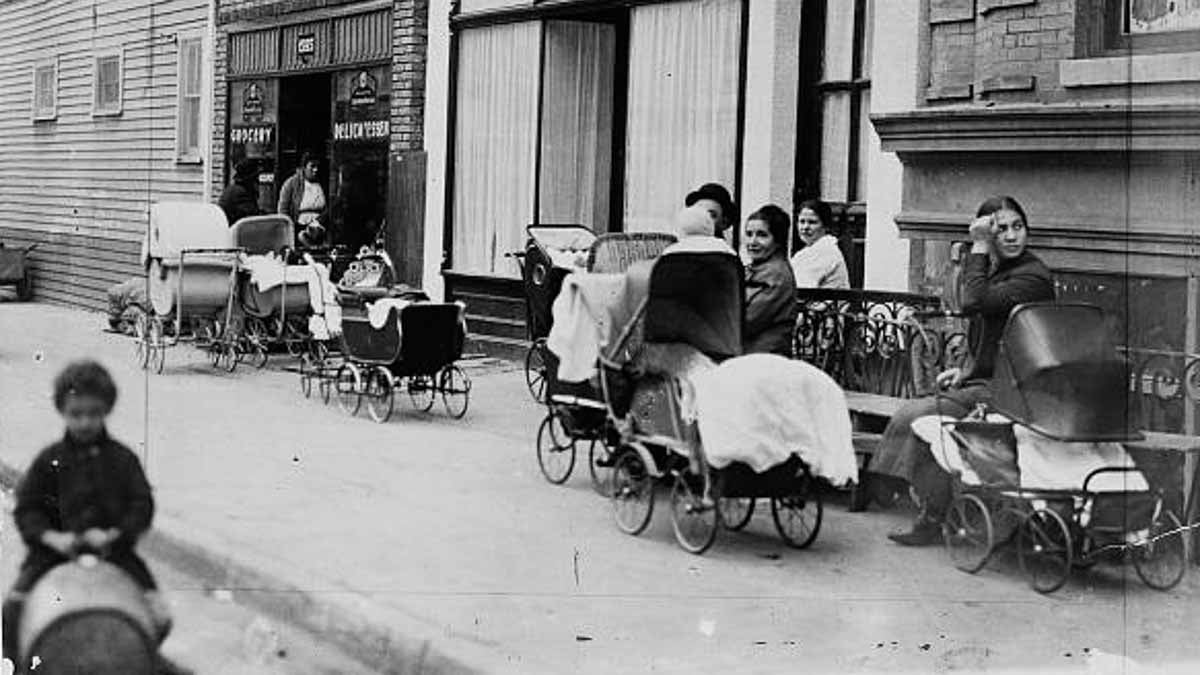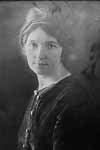A century after the first birth control clinic opened, controversy remains
Listen Photo via New York World-Telegram and the Sun Newspaper Photograph Collection in the Library of Congress)
" title="clinic-3" width="1" height="1"/>
Photo via New York World-Telegram and the Sun Newspaper Photograph Collection in the Library of Congress)
" title="clinic-3" width="1" height="1"/>
Women and men sitting with baby carriages in front of the Sanger Clinic. (Photo via New York World-Telegram and the Sun Newspaper Photograph Collection in the Library of Congress)
Margaret Sanger opened a storefront clinic in 1916, sparking the battleground over women’s reproductive rights.
Brownsville, a working-class neighborhood of Brooklyn, New York, was hot when I stepped off the subway on a Sunday afternoon late this past summer.
The neighborhood has the unfortunate distinction of being called “the murder capital of New York City.” But that day, there was a bustle about the neighborhood, and the sidewalks were filled with families walking home from church.
When I arrived at 46 Amboy Street, I almost didn’t recognize it. On a deserted block off a main thoroughfare, the two-story nondescript brick building seemed abandoned, with all its windows filled with bricks and cement.
I guess I expected there to at least be something functional there…or maybe a plaque commemorating the site? Nope.

46 Amboy Street in Brownsville, Brooklyn, site of Margaret Sanger’s first birth control clinic, as it looks today. (Poncie Rutsch/for WHYY)
You see, 46 Amboy is the epicenter of the debate over “a woman’s right to choose” or maybe “a right to life,” depending on what your politics are—this is the site of the first birth control clinic, opened almost exactly 100 years ago in October 1916. This boarded up building is where the seed for Planned Parenthood was first planted.
But in a 1916 photo, 46 Amboy Street looks anything but lifeless. It’s a different building in the picture—taller, with white walls and an elegant black door. The shades are drawn, but there are women lined up on a bench outside, watching over baby carriages, and waiting to see the clinic’s petite, 37-year-old proprietor, Margaret Sanger.
 Inside the clinic, Sanger would talk about contraception: from the cheap and less effective rhythm method, to more effective barrier methods, using a predecessor to the diaphragm. Sanger wanted all women to have access to some form of birth control, but in pre-World War I America, contraception was a moral dilemma.
Inside the clinic, Sanger would talk about contraception: from the cheap and less effective rhythm method, to more effective barrier methods, using a predecessor to the diaphragm. Sanger wanted all women to have access to some form of birth control, but in pre-World War I America, contraception was a moral dilemma.
(Photo via George Grantham Bain Collection in the Library of Congress)
“You know there’s a tension between sex and reproduction that was still going on in this period. That you have sex to reproduce, you have a duty to god if you will,” says Esther Katz, the Editor and Director of New York University’s online database of Sanger’s writings The Margaret Sanger Papers Project.
Katz has collected every news article and journal entry she can find from Margaret Sanger, including the Family Limitation pamphlet, which Sanger passed out at the clinic. Katz says the pamphlet was considered obscene and deemed illegal by 1916 standards, and therefore illegal. But illegal or not, Sanger knew that women wanted birth control, and her mission was to provide it.
Sanger had witnessed a system that worked with women to prevent pregnancy in the Netherlands. There, women could go to a clinic and simply ask for birth control, and the power that afforded women over their bodies inspired Sanger to open the Brownsville clinic. So, in the fall of 1916, she recruited her sister as a nurse, hired a translator, and posted a flyer in English, Italian, and Yiddish, to advertise her operation.
“Mothers, you don’t have to continue to suffer!” the flyer read.
The clinic opened on October 16, 1916, and shortly thereafter, there was a line out the door. Then, about a week later, a mysterious woman appeared.
“Immediately both Sanger and her sister understood it was a policewoman, posing as a potential patient,” says Katz.
On the clinic’s tenth day in business, the police arrested the clinic’s employees for obscenity. Sanger refused to get in the police car, opting to march herself down to jail. Katz says she knew how to create a scene, and her trial was further proof. She invited many of the women who visited the clinic to her trial.
“So you had a courtroom full of young mothers with babies crying,” says Katz. “Their testimony didn’t help her case, because they said, ‘Yes she helped me out, and I don’t know what I would have done without her.’ That doesn’t really get you to ‘I’m not guilty.”
Sanger was convicted of obsenity, and spent a month in prison, but when she appealed the conviction, Judge Frederick Crane broke with tradition. Crane reasoned that doctors are supposed to prevent disease, so if contraception prevents sexually transmitted disease or a dangerous pregnancy, then it might be a doctor’s best recommendation to keep people healthy.
This was the opportunity Sanger was looking for. She teamed up with a physician and, in 1923, they opened a new clinic and began legally distributing birth control.
“Respectable women, upper class women, women of status, of wealth, were now willing to talk about birth control in a way it had never been discussed before,” says Katz.
Around this time, birth control became a big public debate, and not least of all because it was tied up with the idea of who should be reproducing and who shouldn’t. This idea became codified in the Eugenics movement.
“[Eugenics] was absolutely common from right to left. The socialists believed in eugenics, the most conservative parties believed in eugenics…everyone did,” says Linda Gordon, author of The Moral Property of Women: A history of birth control politics in America.
Gordon is credited with revealing that Sanger made alliances with Eugenists. But, as Esther Katz says, Sanger worked with blinders and had one goal: “Birth control, women need birth control. They’re never going to be equal until they have birth control. That’s all she saw.”
Nothing can excuse Sanger from her interaction with Eugenics; it will probably haunt her legacy forever. When the Nazis adopted eugenics-based policies, the scientific community distanced themselves from the ideology and it fell into the category of racial bias. But Sanger’s involvement in the movement served to put her at the center of the debate over the distribution of birth control, and while it permanently damaged her reputation, it kept the topic in the news.
Sanger would go on to found The American Birth Control League and open more birth control clinics. Eventually, the League and the clinics teamed up to form Planned Parenthood, which operates about 650 branches in the U.S. today.
Poncie Rutsch produces and hosts Babes of Science, a podcast about women’s history in STEM fields. Her episode on Margaret Sanger is available on iTunes.
WHYY is your source for fact-based, in-depth journalism and information. As a nonprofit organization, we rely on financial support from readers like you. Please give today.



